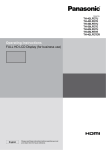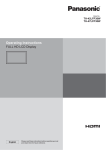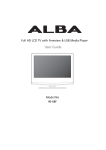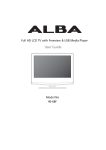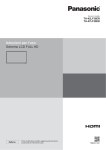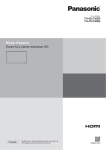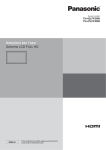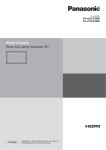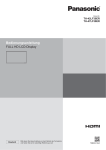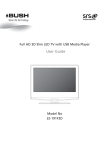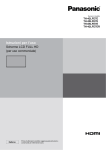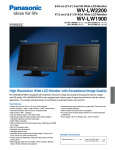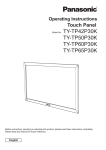Download for Europe, CIS: 1.16 MB
Transcript
Model No. TH-42LF30ER TH-47LF30ER Operating Instructions FULL HD LCD Display h English Please read these instructions before operating your set and retain them for future reference. Dear Panasonic Customer Welcome to the Panasonic family of customers. We hope that you will have many years of enjoyment from your new LCD Display. To obtain maximum benefit from your set, please read these Instructions before making any adjustments, and retain them for future reference. Retain your purchase receipt also, and note down the model number and serial number of your set in the space provided on the rear cover of these instructions. Visit our Panasonic Web Site http://panasonic.net Table of Contents Important Safety Notice ........................................... 3 Safety Precautions ................................................... 4 Accessories .............................................................. 7 Accessories Supply ................................................. 7 Remote Control Batteries ........................................ 7 Connections .............................................................. 8 AC cord connection and ¿xing ................................. 8 Video equipment connection ................................... 8 VIDEO, COMPONENT / RGB IN and HDMI connection .............................................. 9 DVI-D IN, DVI-D OUT connection ......................... 10 PC Input Terminals connection ...............................11 SERIAL Terminals connection ............................... 12 Power On / Off......................................................... 14 Selecting the input signal ...................................... 16 Basic Controls ........................................................ 17 ASPECT Controls ................................................... 19 Digital Zoom ............................................................ 20 On-Screen Menu Displays ..................................... 21 Adjusting Pos. /Size ............................................... 22 Picture Adjustments ............................................... 24 Advanced settings ................................................. 25 Sound Adjustment .................................................. 26 SDI Sound Output ................................................. 26 PRESENT TIME Setup / Set up TIMER .................. 27 PRESENT TIME Setup.......................................... 27 Set up TIMER ........................................................ 28 Screensaver (For preventing image retention) .... 29 Setup of Screensaver Time ................................... 30 Wobbling ................................................................. 30 No activity power off .............................................. 31 ECO Mode settings................................................. 32 Customizing the Input labels................................. 33 Selecting the On-Screen Menu Language............ 34 Customizing the On-Screen Menu Display .......... 34 Setup for MULTI DISPLAY ...................................... 35 How to Setup MULTI DISPLAY ............................. 35 ID Remote Control Function .................................. 36 Setup for Input Signals .......................................... 37 Component / RGB-in select ................................... 37 YUV / RGB-in select .............................................. 37 Signal menu .......................................................... 38 3D Y/C Filter .......................................................... 38 Colour system ....................................................... 39 Cinema reality ....................................................... 39 XGA Mode ............................................................. 39 Noise reduction ..................................................... 40 Sync ...................................................................... 40 HDMI Range .......................................................... 40 Input signal display ................................................ 41 Options Adjustments ............................................. 42 Troubleshooting ..................................................... 45 Applicable Input Signals ........................................ 46 Shipping condition ................................................. 48 Speci¿cations ......................................................... 49 Trademark Credits • VGA is a trademark of International Business Machines Corporation. • Macintosh is a registered trademark of Apple Inc., USA. • SVGA, XGA, SXGA and UXGA are registered trademarks of the Video Electronics Standard Association. Even if no special notation has been made of company or product trademarks, these trademarks have been fully respected. • HDMI, the HDMI Logo, and High-De¿nition Multimedia Interface are trademarks or registered trademarks of HDMI Licensing LLC in the United States and other countries. Note: Image retention may occur. If you display a still picture for an extended period, the image might remain on the screen. However, it will disappear after a while. 2 Important Safety Notice WARNING 1) To prevent damage which may result in ¿re or shock hazard, do not expose this appliance to dripping or splashing. Do not place containers with water (Àower vase, cups, cosmetics, etc.) above the set. (including on shelves above, etc.) No naked Àame sources, such as lighted candles, should be placed on / above the set. 2) To prevent electric shock, do not remove cover. No user serviceable parts inside. Refer servicing to quali¿ed service personnel. 3) Do not remove the earthing pin on the power plug. This apparatus is equipped with a three pin earthing-type power plug. This plug will only ¿t an earthing-type power outlet. This is a safety feature. If you are unable to insert the plug into the outlet, contact an electrician. Do not defeat the purpose of the earthing plug. 4) To prevent electric shock, ensure the earthing pin on the AC cord power plug is securely connected. CAUTION This appliance is intended for use in environments which are relatively free of electromagnetic ¿elds. Using this appliance near sources of strong electromagnetic ¿elds or where electrical noise may overlap with the input signals could cause the picture and sound to wobble or cause interference such as noise to appear. To avoid the possibility of harm to this appliance, keep it away from sources of strong electromagnetic ¿elds. IMPORTANT: THE MOULDED PLUG FOR YOUR SAFETY, PLEASE READ THE FOLLOWING TEXT CAREFULLY. This display is supplied with a moulded three pin mains plug for your safety and convenience. A 10 amp fuse is ¿tted in this plug. Shall the fuse need to be replaced, please ensure that the replacement fuse has a rating of 10 amps and that it is approved by ASTA or BSI to BS1362. Check for the ASTA mark ASA or the BSI mark on the body of the fuse. If the plug contains a removable fuse cover, you must ensure that it is re¿tted when the fuse is replaced. If you lose the fuse cover the plug must not be used until a replacement cover is obtained. A replacement fuse cover can be purchased from your local Panasonic dealer. Do not cut off the mains plug. Do not use any other type of mains lead except the one supplied with this display. The supplied mains lead and moulded plug are designed to be used with this display to avoid interference and for your safety. If the socket outlet in your home is not suitable, get it changed by a quali¿ed electrician. If the plug or mains lead becomes damaged, purchase a replacement from an authorized dealer. WARNING : — THIS DISPLAY MUST BE EARTHED. How to replace the fuse. Open the fuse compartment with a screwdriver and replace the fuse. 3 Safety Precautions WARNING Setup This LCD Display is for use only with the following optional accessories. Use with any other type of optional accessories may cause instability which could result in the possibility of injury. (All of the following accessories are manufactured by Panasonic Corporation.) • Pedestal ....................................................... TY-ST20-K • HD-SDI Terminal Board with audio .............. TY-FB10HD Always be sure to ask a quali¿ed technician to carry out set-up. Small parts can present choking hazard if accidentally swallowed. Keep small parts away from young children. Discard unneeded small parts and other objects, including packaging materials and plastic bags/sheets to prevent them from being played with by young children, creating the potential risk of suffocation. Do not place the Display on sloped or unstable surfaces, and ensure that the Display does not hang over the edge of the base. • The Display may fall off or tip over. Do not place any objects on top of the Display. • If water is spills onto the Display or foreign objects get inside it, a short-circuit may occur which could result in ¿re or electric shock. If any foreign objects get inside the Display, please consult your local Panasonic dealer. Transport only in upright position! • Transporting the unit with its display panel facing upright or downward may cause damage to the internal circuitry. Ventilation should not be impeded by covering the ventilation openings with items such as newspapers, table cloths and curtains. For suf¿cient ventilation; Leave a space of 10 cm or more at the top, left and right, and 5 cm or more at the rear, and also keep the space between the bottom of the display and the Àoor surface. Cautions for Wall Installation • Wall installation should be performed by an installation professional. Installing the Display incorrectly may lead to an accident that results in death or serious injury. Furthermore, when installing on a wall, a wall hanging bracket that conforms to VESA standards (VESA 400 × 400) must be used. • When installing the Display vertically, be sure to install the power indicator onto the bottom of the Display. 4 Safety Precautions When using the LCD Display The Display is designed to operate on 220 - 240 V AC, 50/60 Hz. Do not cover the ventilation holes. • Doing so may cause the Display to overheat, which can cause ¿re or damage to the Display. Do not stick any foreign objects into the Display. • Do not insert any metal or Àammable objects into the ventilations holes or drop them onto the Display, as doing so can cause ¿re or electric shock. Do not remove the cover or modify it in any way. • High voltages which can cause severe electric shocks are present inside the Display. For any inspection, adjustment and repair work, please contact your local Panasonic dealer. Ensure that the mains plug is easily accessible. An apparatus with CLASS I construction shall be connected to a mains socket outlet with a protective earthing connection. Do not use any power supply cord other than that provided with this unit. • Doing so may cause ¿re or electric shocks. Securely insert the power supply plug as far as it will go. • If the plug is not fully inserted, heat may be generated which could cause ¿re. If the plug is damaged or the wall socket is loose, they shall not be used. Do not handle the power supply plug with wet hands. • Doing so may cause electric shocks. Do not do anything that may damage the power cable. When disconnecting the power cable, pull on the plug body, not the cable. • Do not damage the cable, make any modi¿cations to it, place heavy objects on top of it, heat it, place it near any hot objects, twist it, bend it excessively or pull it. To do so may cause ¿re and electric shock. If the power cable is damaged, have it repaired at your local Panasonic dealer. If the Display is not going to be used for any prolonged length of time, unplug the power supply plug from the wall outlet. To prevent the spread of ¿re, keep candles or other open Àames away from this product at all times. If problems occur during use If a problem occurs (such as no picture or no sound), or if smoke or an abnormal odour starts to come out from the Display, immediately unplug the power supply plug from the wall outlet. • If you continue to use the Display in this condition, ¿re or electric shock could result. After checking that the smoke has stopped, contact your local Panasonic dealer so that the necessary repairs can be made. Repairing the Display yourself is extremely dangerous, and shall never be done. If water or foreign objects get inside the Display, if the Display is dropped, or if the cabinet becomes damages, disconnect the power supply plug immediately. • A short circuit may occur, which could cause ¿re. Contact your local Panasonic dealer for any repairs that need to be made. 5 Safety Precautions CAUTION When using the LCD Display Do not bring your hands, face or objects close to the ventilation holes of the Display. • Heated air comes out from the ventilation holes at the top of Display will be hot. Do not bring your hands or face, or objects which cannot withstand heat, close to this port, otherwise burns or deformation could result. Be sure to disconnect all cables before moving the Display. • If the Display is moved while some of the cables are still connected, the cables may become damaged, and ¿re or electric shock could result. Disconnect the power supply plug from the wall socket as a safety precaution before carrying out any cleaning. • Electric shocks can result if this is not done. Clean the power cable regularly to prevent it becoming dusty. • If dust built up on the power cord plug, the resultant humidity can damage the insulation, which could result in ¿re. Pull the power cord plug out from the wall outlet and wipe the mains lead with a dry cloth. Do not burn or breakup batteries. • Batteries must not be exposed to excessive heat such as sunshine, ¿re or the like. Cleaning and maintenance The front of the display panel has been specially treated. Wipe the panel surface gently using only a cleaning cloth or a soft, lint-free cloth. • If the surface is particularly dirty, wipe with a soft, lint-free cloth which has been soaked in pure water or water in which neutral detergent has been diluted 100 times, and then wipe it evenly with a dry cloth of the same type until the surface is dry. • Do not scratch or hit the surface of the panel with ¿ngernails or other hard objects, otherwise the surface may become damaged. Furthermore, avoid contact with volatile substances such as insect sprays, solvents and thinner, otherwise the quality of the surface may be adversely affected. If the cabinet becomes dirty, wipe it with a soft, dry cloth. • If the cabinet is particularly dirty, soak the cloth in water to which a small amount of neutral detergent has been added and then wring the cloth dry. Use this cloth to wipe the cabinet, and then wipe it dry with a dry cloth. • Do not allow any detergent to come into direct contact with the surface of the Display. If water droplets get inside the unit, operating problems may result. • Avoid contact with volatile substances such as insect sprays, solvents and thinner, otherwise the quality of the cabinet surface may be adversely affected or the coating may peel off. Furthermore, do not leave it for long periods in contact with articles made from rubber or PVC. Usage of a chemical cloth • Do not use a chemical cloth for the panel surface. • Follow the instructions for the chemical cloth to use it for the cabinet. 6 Accessories Accessories Supply Check that you have the accessories and items shown Operating Instruction book CD-ROM (Operating instructions) Remote Control Transmitter N2QAYB000691 Batteries for the Remote Control Transmitter (R6 (UM3) Size × 2) Power supply cord Remote Control Batteries Requires two R6 batteries. 1. Pull and hold the hook, then open the battery cover. 2. Insert batteries - note correct polarity ( + and -). 3. Replace the cover. “R6 (UM3)” size + + - Helpful Hint: For frequent remote control users, replace old batteries with Alkaline batteries for longer life. Precaution on battery use Incorrect installation can cause battery leakage and corrosion that will damage the remote control transmitter. Disposal of batteries should be in an environment-friendly manner. Observe the following precaution: 1. Batteries shall always be replaced as a pair. Always use new batteries when replacing the old set. 2. Do not combine a used battery with a new one. 3. Do not mix battery types (example: “Zinc Carbon” with “Alkaline”). 4. Do not attempt to charge, short-circuit, disassemble, heat or burn used batteries. 5. Battery replacement is necessary when remote control acts sporadically or stops operating the Display set. 6. Do not burn or breakup batteries. Batteries must not be exposed to excessive heat such as sunshine, ¿re or the like. 7 Connections AC cord connection and ¿xing AC cord ¿xing Unplug the AC cord Plug the AC cord into the display unit. Plug the AC cord until it clicks. Note: Make sure that the AC cord is locked on both the left and right sides. Unplug the AC cord pressing the two knobs. Note: When disconnecting the AC cord, be absolutely sure to disconnect the AC cord plug at the socket outlet ¿rst. Video equipment connection AUDIO IN (COMPOSITE) Connect the audio output of a device connected to VIDEO. (see page 9) AV IN HDMI1, HDMI2 HDMI Input Terminal (see page 9) SERIAL IN, SERIAL OUT SERIAL Input/Output Terminal Control the Display by connecting to PC. (see page 12) 8 AUDIO IN (COMPONENT / RGB) Connect the audio output of a device connected to COMPONENT/RGB IN. (see page 9) DVI-D IN, DVI-D OUT DVI-D Input/Output Terminal (see page 10) PC IN PC Input Terminal (see page 11) AUDIO IN (DVI-D / PC) Connect the audio output of a device connected to DVI-D IN, PC IN. (see page 10, 11) VIDEO Composite Video Input Terminal (see page 9) COMPONENT/RGB IN Component/RGB Video Input Terminal (see page 9) Connections VIDEO, COMPONENT / RGB IN and HDMI connection Note: Additional equipment, cables and adapter plugs shown are not supplied with this set. [Pin assignments and signal names for HDMI terminal] Pin No. DVD Player VCR AUDIO OUT L 3 4 R 5 6 7 8 9 10 11 Signal Name T.M.D.S Clock Shield 12 T.M.D.S Clock- 13 CEC 14 Reserved (N.C. on device) 15 16 17 18 19 SCL SDA DDC/CEC Ground +5V Power Hot Plug Detect 3 1 19 RCA-BNC Adapter plug Pin No. T.M.D.S Data2 Shield T.M.D.S Data2T.M.D.S Data1+ T.M.D.S Data1 Shield T.M.D.S Data1T.M.D.S Data0+ T.M.D.S Data0 Shield T.M.D.S Data0T.M.D.S Clock+ 2 VIDEO OUT Signal Name T.M.D.S Data2+ 1 4 2 18 RCA-BNC Adapter plug HDMI cables Notes: • Change the “Component/RGB-in select” setting in the “Setup” menu to “Component” (when Component signal connection) or “RGB” (when RGB signal connection). (see page 37) • Accepts only RGB signals from COMPONENT/RGB IN terminal with “Sync on G”. HDMI AV OUT DVD player L HDMI AV OUT DVD player Y PB PR OUT R AUDIO OUT Computer RGB OUT RGB Camcorder DVD Player 9 Connections DVI-D IN, DVI-D OUT connection PC with DVI-D video out Stereo mini plug (M3) Shared with PC IN. DVI-video cable with Ferrite core (Within 5 m) Daisy chain connection When using the multi display, multiple LCD Displays can be daisy chained. First LCD Display PC with DVI-D video out * Second LCD Display Third and subsequent LCD Displays * * DVI-video cable with Ferrite core Notes: • Up to 10 displays can be connected with a daisy chain, but the number of the connected displays may be limited by a cable, signal or equipment to use. • HDCP can be supported for up to 8 displays for a daisy chain. DVI-D Input/Output Connector Pin Layouts 1 8 9 16 17 24 Connection port view Pin No. 1 2 3 4 5 6 7 8 9 10 11 12 Signal Name T.M.D.S. data 2T.M.D.S. data 2+ T.M.D.S. data 2 shield DDC clock DDC data T.M.D.S. data 1T.M.D.S. data 1+ T.M.D.S. data 1 shield Pin No. 13 14 15 16 17 18 19 20 21 22 23 24 Signal Name +5 V DC Ground Hot plug detect T.M.D.S. data 0T.M.D.S. data 0+ T.M.D.S. data 0 shield T.M.D.S. clock shield T.M.D.S. clock+ T.M.D.S. clock- Notes: • Additional equipment and cables shown are not supplied with this set. • Use the DVI-D cable with Ferrite core complying with the DVI standard. Image deterioration may occur depending on the length or the quality of the cable. 10 Connections PC Input Terminals connection (Female) COMPUTER Shared with DVI-D IN. Audio Stereo mini plug (M3) Connect a cable which matches the audio output terminal on the computer. Conversion adapter (if necessary) RGB PC cable with Ferrite core Mini D-sub 15p (Male) Notes: • Computer signals which can be input are those with a horizontal scanning frequency of 30 to 110 kHz and vertical scanning frequency of 48 to 120 Hz. (However, the image will not be displayed properly if the signals exceed 1,200 lines.) • The display resolution is a maximum of 1,440 × 1,080 dots when the aspect mode is set to “4:3”, and 1,920 × 1,080 dots when the aspect mode is set to “16:9”. If the display resolution exceeds these maximums, it may not be possible to show ¿ne detail with suf¿cient clarity. • The PC input terminals are DDC2B-compatible. If the computer being connected is not DDC2B-compatible, you will need to make setting changes to the computer at the time of connection. • Some PC models cannot be connected to the set. • There is no need to use an adapter for computers with DOS/V compatible Mini D-sub 15P terminal. • The computer shown in the illustration is for example purposes only. • Additional equipment and cables shown are not supplied with this set. • Panasonic recommends using a PC cable that includes a Ferrite core. • Do not set the horizontal and vertical scanning frequencies for PC signals which are above or below the speci¿ed frequency range. Signal Names for Mini D-sub 15P Connector 5 4 10 9 3 2 8 1 7 6 15 14 13 12 11 Pin Layout for PC Input Terminal Pin No. Signal Name Pin No. Signal Name Pin No. Signal Name 1 R 6 GND (Ground) 11 NC (not connected) 2 G 7 GND (Ground) 12 SDA 3 B 8 GND (Ground) 13 HD/SYNC 4 NC (not connected) 9 +5 V DC 14 VD 5 GND (Ground) 10 GND (Ground) 15 SCL 11 Connections SERIAL Terminals connection The SERIAL terminal is used when the Display is controlled by a computer. COMPUTER RS-232C Straight cable (Female) (Male) D-sub 9p In addition, a particular LCD Display can be controlled with a PC while several LCD Displays are daisy chained. COMPUTER First LCD Display Second LCD Display (Male) (Male) (Female) (Female) (Female) (Female) (Female) Third LCD Display * * * (Male) D-sub 9p * RS-232C Straight cable Notes: • Use the RS-232C straight cable to connect the computer to the Display. • The computer shown is for example purposes only. • Additional equipment and cables shown are not supplied with this set. • When using daisy chain, set ”Serial Daisy Chain” in the Options menu. (see page 43) • For daisy chain connection, use a straight cable connected to pins numbered 2 through 8 . 1 2 6 3 7 4 8 5 9 Pin layout for SERIAL Terminal The SERIAL terminal conforms to the RS-232C interface speci¿cation, so that the Display can be controlled by a computer which is connected to this terminal. The computer will require software which allows the sending and receiving of control data which satis¿es the conditions given below. Use a computer application such as programming language software. Refer to the documentation for the computer application for details. Communication parameters Signal level Synchronization method Baud rate Parity Character length Stop bit Flow control RS-232C compliant Asynchronous 9600 bps None 8 bits 1 bit - Signal names for SERIAL IN terminal Pin No. 2 3 4 5 6 7 8 1 • 9 Details RXD TXD DTR GND DSR (Shorted in this set) NC These signal names are those of computer speci¿cations. 12 Connections Basic format for control data The transmission of control data from the computer starts with a STX signal, followed by the command, the parameters, and lastly an ETX signal in that order. If there are no parameters, then the parameter signal does not need to be sent. STX C1 C2 C3 Start (02h) : P1 P2 P3 P4 P5 ETX Colon Parameter(s) (1 - 5 bytes) 3-character command (3 bytes) End (03h) Notes: • If multiple commands are transmitted, be sure to wait for the response for the ¿rst command to come from this unit before sending the next command. • If an incorrect command is sent by mistake, this unit will send an “ER401” command back to the computer. • Consult an Authorized Service Center for detail instructions on command usage. Command Command PON POF AVL AMT IMS DAM Parameter None None *** 0 1 None SL1 AV1 AV2 HM1 HM2 DV1 PC1 None ZOOM FULL NORM ZOM2 Control details Power ON Power OFF Volume 000 - 100 Audio MUTE OFF Audio MUTE ON Input select (toggle) SLOT input (SLOT INPUT) VIDEO input (VIDEO) COMPONENT/RGB IN input (Component) HDMI1 input (HDMI1) HDMI2 input (HDMI2) DVI-D IN input (DVI) PC IN input (PC) Screen mode select (toggle) Zoom1 16:9 4:3 Zoom2 With the power off, this display responds to PON command only. 13 Power On / Off Connecting the AC cord plug to the Display. Connecting the plug to the Wall Outlet Notes: • Main plug types vary between countries. The power plug shown at right may, therefore, not be the type ¿tted to your set. • When disconnecting the AC cord, be absolutely sure to disconnect the AC cord plug at the socket outlet ¿rst. Power switch Press the Power switch on the Display to turn the set on: Power-On. Remote Control Sensor Power Indicator Power Indicator: Green Press the button on the remote control to turn the Display off. Power Indicator: Red (standby) Press the button on the remote control to turn the Display on. Power Indicator: Green Turn the power to the Display off by pressing the the Display is on or in standby mode. switch on the unit, when Note: During operation of the power management function, the power indicator turns orange in the power off state. 14 Power On / Off When ¿rst switching on the unit Following screen will be displayed when the unit is turned on for the ¿rst time. Select the items with the remote control. Unit buttons are invalid. OSD Language English (UK) OSD Language Deutsch Français 1 Select the language. Italiano Español 2 ENGLISH (US) Set. PRESENT TIME Setup 1 Select “DAY” or “PRESENT TIME”. 2 Setup “DAY” or “PRESENT TIME”. PRESENT TIME Setup PRESENT TIME 1 Select “Set”. Set. MON 99 : 99 DAY PRESENT TIME PRESENT TIME Setup PRESENT TIME 2 MON 99 : 99 Set MON 99 : 99 Set DAY PRESENT TIME TUE 10 : 00 Notes: • Once the items are set, the screens won't be displayed when switching on the unit next time. • After the setting, the items can be changed in the following menus. OSD Language (see page 34) PRESENT TIME Setup (see page 27) Power ON warning message The following message may be displayed when turning the unit power ON: No activity power off Precautions ’No activity power off’ is enabled. If “No activity power off” in Setup menu is set to “Enable”, a warning message is displayed every time the power is turned ON. (see page 31) This message display can be set with the following menu: Options menu Power On Message (see page 44) 15 Selecting the input signal Press to select the input signal to be played back from the equipment which has been connected to the Display. Input signals will change as follows: HDMI1 HDMI2 VIDEO Component* PC DVI HDMI1: HDMI input terminal in AV IN (HDMI1). HDMI2: HDMI input terminal in AV IN (HDMI2). VIDEO: Video input terminal in VIDEO. Component*: Component or RGB input terminal in COMPONENT/RGB IN. PC: PC input terminal in PC IN. DVI: DVI input terminal in DVI-D IN. * “Component” may be displayed as “RGB” depending on the setting of “Component/RGB-in select”. (see page 37) When an optional Terminal Board is installed: HDMI1 HDMI2 SLOT INPUT VIDEO Component SLOT INPUT: Input terminal in Terminal Board Note: When a Terminal Board incompatible with the Display is installed, “Non-Compatible Function Board” is displayed. Notes: • Selecting is also possible by pressing the INPUT button on the unit. • Select to match the signals from the source connected to the component/RGB input terminals. (see page 37) 16 PC DVI Basic Controls Main Unit Remote control Brightness Sensor sensor Detects the brightness in the viewing environment. Power Indicator The Power Indicator will light. • Power-OFF .... Indicator not illuminated (The unit will still consume some power as long as the power cord is still inserted into the wall outlet.) • Standby ........ Red Orange (When “Slot power” is set to “On”. See page 43) Orange (Depending on the type of the function board installed, when the power is supplied to the slot) • Power-ON ...... Green • PC Power management (DPMS) ......................... Orange (With PC input signal. See page 32) • DVI-D Power management ....................... Orange (With DVI input signal. See page 32) SLOT: Terminal board (optional accessories) insert slot (see page 4 ) Note: The upper side slot is for terminal board with 2-slot width. The terminal board with 1-slot width does not function when installed in the upper side slot. Speakers Enter / Aspect button (see page 19, 21) Volume Adjustment Volume Up “+” Down “–” When the menu screen is displayed: “+” : press to move the cursor up “–” : press to move the cursor down (see page 21) Main Power On / Off Switch MENU Screen ON / OFF Each time the MENU button is pressed, the menu screen will switch. (see page 21) Normal Viewing Picture Setup Sound Pos. /Size INPUT button (INPUT signal selection) (see page 16) 17 Basic Controls Remote Control Transmitter ACTION button Press to make selections. ASPECT button Press to adjust the aspect. (see page 19) Standby (ON / OFF) button The Display must ¿rst be plugged into the wall outlet and turned on at the power switch (see page 14). Press this button to turn the Display On, from Standby mode. Press it again to turn the Display Off to Standby mode. POS. /SIZE button (see page 22) PICTURE button (see page 24) Sound mute On / Off Press this button to mute the sound. Press again to reactivate sound. Sound is also reactivated when power is turned off or volume level is changed. N button (see page 23, 24, 25, 26) POSITION buttons INPUT button Press to select Input signal sequentially. (see page 16) ECO MODE (ECO) Press to change the ECO MODE setup status. (see page 32) FUNCTION buttons (FUNCTION) (see page 44) OFF TIMER button The Display can be preset to switch to stand-by after a ¿xed period. The setting changes to 30 minutes, 60 minutes, 90 minutes and 0 minutes (off timer cancelled) each time the button is pressed. 30 min 60 min 90 min 0 min When three minutes remain, “Off timer 3 min” will Àash. The off timer is cancelled if a power interruption occurs. AUTO SETUP button Automatically adjusts the position/ size of the screen. (see page 22) SET UP button (see page 21) SOUND button (see page 26) Volume Adjustment Press the Volume Up “+” or Down “–” button to increase or decrease the sound volume level. R button (see page 21) Press the R button to return to previous menu screen. RECALL button Press the “RECALL” button to display the current system status. 1 Input label 2 Aspect mode (see page 19) 3 Off timer The off timer indicator is displayed only when the off timer has been set. 4 Clock Display (see page 44) 1 2 PC 4:3 4 10:00 Off timer 90min Digital Zoom (see page 20) 18 3 ASPECT Controls The Display will allow you to enjoy viewing the picture at its maximum size, including wide screen cinema format picture. Note: Be aware that if you put the display in a public place for commercial purposes or a public showing and then use the aspect mode select function to shrink or expand the picture, you may be violating the copyright under copyright law. It is prohibited to show or alter the copyrighted materials of other people for commercial purposes without the prior permission of the copyright holder. Press repeatedly to move through the aspect options: 4:3 Zoom1 Zoom2 16:9 [from the unit] The aspect mode changes each time the ENTER button is pressed. Note: The aspect mode is memorized separately for each input terminal. Aspect mode 16:9 Picture Enlarged screen Description The display of the pictures ¿lls the screen. In the case of SD signals, pictures with a 4:3 aspect ratio are enlarged horizontally, and displayed. This mode is suited to displaying anamorphic pictures with a 16:9 aspect ratio. Pictures with a 4:3 aspect ratio are displayed with their original aspect ratio. Side panels are displayed at the left and right edges of the screen. 4:3 Zoom1 Zoom2 The pictures with a 4:3 aspect ratio among the 16:9 aspect ratio signals are displayed with their original aspect ratio. The left and right edges of the pictures are masked with side panels. Letterbox pictures with a 16:9 aspect ratio are enlarged vertically and horizontally so that their display ¿lls the screen. The top and bottom edges of the pictures are cut off. Letterbox pictures with a 16:9 aspect ratio are enlarged vertically and horizontally so that their display ¿lls the screen. The top and bottom edges as well as the left and right edges of the pictures are cut off. 19 Digital Zoom This displays an enlargement of the designated part of the displayed image. 1 Display the operation guide. Exit Press to access Digital Zoom. The operation guide will be displayed. 1 During Digital Zoom, only the following buttons can be operated. [Remote control] POSITION / ACTION button 2 Select the area of the image to be enlarged. Press on the enlargement location to select. The cursor will move. Exit 2 3 Select the magni¿cation required for the enlarged display. Each time this is pressed, the magni¿cation factor changes. This is shown in the image being displayed. ×1 4 ×2 Return to normal display (quit Digital Zoom). Press to exit from the Digital Zoom. Notes: • When power goes OFF (including “Off Timer” operation), Digital Zoom terminates. • The Digital Zoom function cannot be selected while in the following operation state: When MULTI DISPLAY Setup is On (see page 35). When Screensaver is running (see page 29) • While Digital Zoom is in operation, “Adjusting Pos. / Size” cannot be used. 20 ×3 ×4 On-Screen Menu Displays Remote Control Unit 1 Display the menu screen. Press to select. (Example: Picture menu) 2 Select the item. Select. Picture Normalise Press several times. Each time the MENU button is pressed, the menu screen will switch. Normal Viewing Picture Setup Sound Pos. /Size Press. Normal Picture Mode Backlight Contrast Brightness Colour Tint Sharpness White balance Advanced settings Normal 100 70 50 50 50 50 Select. Normal (Example: Picture menu) 3 Set. Adjust. Press. Adjust. 4 Exit the menu. Press. Press several times. Press to return to the previous menu. Menu display list Note: Menu that cannot be adjusted is grayout. Adjustable menu changes depending on signal, input and menu setting. Picture menu Setup menu Picture Normalise Pos./Size menu Setup Normal Picture Mode Backlight Contrast Brightness Colour Tint Sharpness White balance Advanced settings Normal 100 70 50 50 50 50 Signal Screensaver Input label ECO Mode settings Wobbling Component/RGB-in select 1/2 Normalise Auto Setup Off RGB Normal No activity power off OSD Language Disable English(UK) See page 24, 25 Setup MULTI DISPLAY Setup Set up TIMER PRESENT TIME Setup Menu Display Duration Menu Transparency 20 2/2 Sound menu Pos. /Size H-Pos H-Size V-Pos V-Size Clock Phase Dot Clock 1:1 Pixel Mode 1/2 Sound Normalise Normal Sound Mode Bass Treble Balance Surround 0 0 0 0 0 0 See page 22, 23 Normal Off SDI Sound Output Left Channel Right Channel Sound Out Level Meter Normal 0 0 0 Off 2/2 Channel 1 Channel 1 Off Off See page 26 15 S See page 27-41 21 Adjusting Pos. /Size 1 Press to display the Pos. /Size menu. 2 Press to select the menu to adjust. 3 Press to adjust the menu. 4 Press to exit from adjust mode. Pos. /Size Normalise Auto Setup H-Pos H-Size V-Pos V-Size Clock Phase Dot Clock 1:1 Pixel Mode Normal 0 0 0 0 0 0 Off Notes: Unadjustable items are grayed out. Adjustable items differ depending on the input signal and the display mode. Note: If a “Cue” or “Rew” signal from a VCR or DVD player is received, the picture position will shift up or down. This picture position movement cannot be controlled by the Picture Pos./Size function. Auto Setup H-Pos/V-Pos, H-Size/V-Size, Dot Clock and Clock Phase are automatically adjusted when the RGB or PC signal is received. This setting only operates when a PC signal or RGB signal is input, and the aspect is “16:9”. Using Remote Control When on the remote control is pressed, “Auto Setup” will be executed. When Auto Setup does not work, “Invalid” is displayed. Notes: • Auto Setup may not work when a cropped or dark image is input. In such case, switch to a bright image with borders and other objects are clearly shown, and then try auto setup again. • Depending on the signal, out of alignment may occur after Auto Setup. Carry out ¿ne tuning for the position/size as required. • If Auto Setup cannot set properly for vertical frequency 60Hz XGA signal (1024×768@60Hz and 1366×768@60Hz), pre-selecting the individual signal in “XGA Mode” (see page 39) may results in correct Auto Setup. • Auto Setup does not work well when a signal such as additional information is superimposed out of valid image period or intervals between synchronizing and image signals are short. • If Auto Setup cannot adjust correctly, select “Normalise” once and press ACTION ( ), then adjust Pos. /Size manually. • If the picture goes off screen in the horizontal direction as a result of performing Auto Setup, perform Dot Clock adjustment. 22 Adjusting POS. /SIZE H-Pos Adjust the horizontal position. V-Pos Adjust the vertical position. H-Size Adjust the horizontal size. V-Size Adjust the vertical size. Clock Phase (During Component, RGB and PC input signal) Eliminate the Àickering and distortion. Dot Clock (During Component, RGB and PC input signal) Periodic striped pattern interference (noise) may occur when a striped pattern is displayed. If this happens, adjust so that any such noise is minimized. Over scan Turn image over scan On/Off. Con¿gurable signals are as follows: 525i, 525p, 625i, 625p, 750/60p, 750/50p (Component Video, DVI, HDMI) On Off Notes: • “Off” is effective during only “16:9” aspect mode. • When “Off” is set, “H-Size” and “V-Size” cannot be adjusted. 1:1 Pixel Mode Adjusts the display size when 1125i or 1125p signal is input. Notes: • “On” is effective during only “16:9” aspect mode. • Select On when you would like to replay 1920 × 1080 input signal. • Applicable input signal; 1125 (1080) / 50i · 60i · 24sF · 24p · 25p · 30p · 50p · 60p • Select Off when Àickering is shown around the image. • H-Size and V-Size cannot be adjusted when On is selected. Off Helpful Hint ( On / Normalise Normalisation) While the Pos. / Size display is active, if either the N button on the remote control is pressed at any time or the ACTION ( ) button is pressed during “Normalise”, then all adjustment values (except “Clock Phase” and “Dot Clock”) are returned to the factory settings. 23 Picture Adjustments 1 Press to display the Picture menu. 2 Select to adjust each item. Press to select the menu to adjust. Select the desired level by looking at the picture behind the menu. Note: Menu that cannot be adjusted is grayout. Adjustable menu changes depending on signal, input and menu setting. Picture Normalise Press “ ” or “ ” button to switch between modes. Normal Normal Normal Picture Mode Backlight Contrast Brightness Colour Tint Sharpness White balance Advanced settings Dynamic Cinema 100 70 50 50 50 50 Normal For viewing in standard (evening lighting) environments. This menu selects the normal levels of Brightness and Contrast. Normal Dynamic For viewing in brighter environments. This menu selects higher than normal levels of Brightness and Contrast. Press to enter Advanced settings . Cinema Ideal for movies. Advanced settings Enables ¿ne picture adjustment at a professional level (see next page). Advanced settings Normalise Note: If you would like to change the picture and colour of the selected Picture menu to something else, adjust using the items in the Picture menu. (see next page) Normal Input level Gamma AGC W/B High R W/B High G W/B High B W/B Low R W/B Low G W/B Low B Helpful Hint ( 0 2.2 Off Press “ ” or “ ” button to switch between modes. 50 50 50 50 50 50 Normal / Normalise Warm Cool Normalisation) While the “Picture” menu is displayed, if either the N button on the remote control is pressed at any time or the ACTION ( ) button is pressed during “Normalise”, then all adjustment values are returned to the factory settings. 24 Picture Adjustments Item Backlight Contrast Brightness Colour Tint Sharpness Effect Darker Adjustments Brighter Adjusts luminance of the back light. More Selects the proper brightness and density for the room. Less Darker Brighter Less More Reddish Greenish Less More Adjusts for easier viewing of dark pictures such as night scenes and black hair. Adjusts colour saturation. Adjusts for nice skin colour. Notes: • “Colour” setting can be adjusted for Video input signal. • You can change the level of each function (Backlight, Contrast, Brightness, Colour, Tint, Sharpness) for each Picture Mode. • The setting details for normal, dynamic and cinema respectively are memorized separately for each input terminal. • The “Tint” setting can be adjusted for NTSC signal only during Video input signal. • “Backlight” can be adjusted when “ECO Mode” is set to “Custom” and “Power save” to “Off”. (see page 32) Adjusts picture sharpness. Advanced settings Item Input level Effect Details Less More Down Up Off On W/B High R Less More W/B High G Less More W/B High B Less More Less More Less More Less More Gamma AGC W/B Low R W/B Low G W/B Low B Adjustment of parts which are extremely bright and hard to see. S Curve 2.0 2.2 2.6 Increases the brightness of dark signal automatically. Adjusts the white balance for light red areas. Adjusts the white balance for light green areas. Adjusts the white balance for light blue areas. Adjusts the white balance for dark red areas. Adjusts the white balance for dark green areas. Adjusts the white balance for dark blue areas. Notes: • Carry out “W/B” adjustment as follows. 1. Adjust the white balance of the bright sections using the “W/B High R”, “W/B High G” and “W/B High B” settings. 2. Adjust the white balance of the dark sections using the “W/B Low R”, “W/B Low G” and “W/B Low B” settings. 3. Repeat steps 1 and 2 to adjust. Steps 1 and 2 affect each other’s settings, so repeat each step in turn to make the adjustment. • The adjustment values are memorized separately for each input terminal. • The adjustment range values should be used as an adjustment reference. Helpful Hint ( / Normalise Normalisation) On the remote control unit, while the “Advanced settings” menu is displayed, if either the N button is pressed at any time or the ACTION ( ) button is pressed during “Normalise”, then all adjustment values are returned to the factory settings. 25 Sound Adjustment 1 Normalise 2 1/2 Sound Press to display the Sound menu. Sound Mode Bass Treble Balance Surround Select to adjust each item. Press to select the menu to adjust. Normal Normal 0 0 0 Off Select the desired level by listening to the sound. 3 Press to exit from adjust mode. Item Sound Mode Details Normal: Emits the original sound. Dynamic: Accentuates sharp sound. Clear: Attenuates human voice. Bass Adjusts low pitch sounds. Treble Adjusts high pitch sounds. Balance Surround Adjusts left and right volumes. Select On or Off. Note: Bass, Treble and Surround settings are memorized separately for each Sound Mode. Helpful Hint ( / Normalise Normalisation) While the “Sound” menu is displayed, if either the N button on the remote control is pressed at any time or the ACTION ( ) button is pressed during “Normalise”, then all adjustment values are returned to the factory settings. SDI Sound Output This menu is available only when selecting a slot that the following terminal board is installed: HD-SDI Terminal Board with audio (TY-FB10HD) SDI Sound Output Left Channel Right Channel Sound Out Level Meter 26 2/2 Channel 1 Channel 1 Off Off Item Left Channel Right Channel Details Channel 1 to Channel 16 Selects left audio channel. Channel 1 to Channel 16 Selects right audio channel. Off Enables audio output. Disables audio output. Sound Out On On: Off: Level Meter 1-8ch 9-16ch Off Sets audio channels to show in the audio level meter. 8 channels are displayed in the audio level meter; 4 channels each on both right and left sides of the display. Off: Hides the audio level meter. 1-8ch: Displays the audio level meter (1-8ch) 9-16ch: Displays the audio level meter (9-16ch) PRESENT TIME Setup / Set up TIMER The timer can switch the Display On or Off. Before attempting Timer Set, con¿rm the PRESENT TIME and adjust if necessary. Then set POWER ON Time / POWER OFF Time. 1 2 Press to display the Setup menu. Press to select Set up TIMER or PRESENT TIME Setup. Press to display the Set up TIMER screen or PRESENT TIME Setup screen. Setup MULTI DISPLAY Setup Set up TIMER PRESENT TIME Setup Menu Display Duration Menu Transparency 20 2/2 15 S PRESENT TIME Setup 1 2 Press to select DAY or PRESENT TIME. PRESENT TIME Setup PRESENT TIME MON 99 : 99 Press to setup DAY or PRESENT TIME. Set button: Forward MON DAY button: Back 99 : 99 PRESENT TIME Notes: • Pressing “ ” or “ ” button once changes PRESENT TIME 1 minute. • Pressing “ ” or “ ” button continuously changes PRESENT TIME by 15 minutes. Press to select Set. Press to store PRESENT TIME Setup. Notes: • Set cannot be selected unless PRESENT TIME is set. • Unless setting the present time other than “99:99”, “DAY” and “PRESENT TIME” can not be set. • The settings of “DAY” and “PRESENT TIME” are reset when leaving the display turned off for about 7 days for the following reasons: switch of the unit to turn off the display. Pressing Disconnecting the AC cord. Interruption of power supply. 27 PRESENT TIME Setup / Setup TIMER Set up TIMER Set the program for turning the power On/Off and select the input signal at the speci¿ed time. Up to 20 programs can be set. [Setting Example] Program 1, Every Monday, 12:00, Power On, Input: VIDEO Set up TIMER PRESENT TIME MON 0 : 03 1 Program On Timer Function MON Day Power Mode Power On Time 12 : 00 Input VIDEO 1 Set the program number. 2 To execute the program, set to “On”. The program is disabled when “Off” is set. 3 Set the day. The program is executed every day when “Everyday” is set. 1 select 4 Set the power On/Off. 2 adjust 5 Set the time. Pressing “ ” or “ ” button once changes “Time” 1 minute. Pressing “ ” or “ ” button continuously changes “Time” by 15 minutes. 6 Set the input. Notes: • This function cannot be set unless “PRESENT TIME Setup” is set. • If more than one programs are set for the same time, only the program with the smallest program number is enabled. 28 Screensaver (For preventing image retention) Do not display a still picture, especially in 4:3 mode, for any length of time. If the display must remain on, a Screensaver should be used. When the screen saver is operating, the following 5 patterns are displayed full screen for 5 seconds each. BlackĺDark GrayĺGrayĺLight GrayĺWhite 1 Press to display the Setup menu. Press to select Screensaver. 2 Press to display Screensaver screen. Setup 1/2 Signal Screensaver Input label ECO Mode settings Wobbling Component/RGB-in select Off RGB No activity power off OSD Language Disable English(UK) Screensaver PRESENT TIME MON 0 : 02 Start Mode 3 Mode selection Press to select Mode. Press to select each mode items. 4 Off Start setting Off Interval : Operates when Periodic Time and Operating Time are setup and those times arrive. Time Designation : Operates when Start Time and Finish Time are setup and those times arrive. Standby after SCR Saver: Operates while Screensaver duration, and display enters standby mode. On : Operates when Start is selected and the ACTION ( ) button is pressed. When the Mode is set to On, press to select Start. Press to start Screensaver. The menu screen will disappear and the Screensaver will be activated. To stop the Screensaver under On, press the R button or any buttons on the main unit. Note: When the display is turned off, the Scrensaver will be deactivated. 29 Screensaver (For preventing image retention) Setup of Screensaver Time After selecting Time Designation, Interval or Standby after SCR Saver, the relevant Time Setup will become available for selection and the Operating Time may be set. (Time cannot be set when “Mode” is “On” or “Off”.) Press to select Start Time / Finish Time (When Time Designation is selected). Press to select Periodic Time / Operating Time (When Interval is selected). Press to select Screensaver duration (When Standby after SCR Saver is selected). Press to setup. button: Forward button: Back Notes: • Pressing “ ” or “ ” button once changes the Time 1 minute. [However, switching occurs every 15 minutes when Periodic Time is selected.] • Pressing “ ” or “ ” button continuously changes the Time by 15 minutes. • “Screensaver duration” of the “Standby after SCR Saver” can be set from 0:00 to 23:59. When this is set to “0:00”, “ Standby after SCR Saver” will not be activated. Screensaver PRESENT TIME MON 15 : 00 Start Time Designation Mode 6 : 15 Start Time 12 : 30 Finish Time Screensaver PRESENT TIME MON 15 : 00 Start Interval Mode 12 : 00 Periodic Time 3 : 00 Operating Time Screensaver PRESENT TIME MON 15 : 00 Start Standby after SCR Saver Mode 6 : 15 Screensaver duration Note: Timer function will not work unless “PRESENT TIME” is set. Wobbling Automatically shifts the display image (therefore unnoticeable to the eye) to prevent image retention of sharper contour of image. 1 2 Press to display the Setup menu. Press to select “Wobbling”. Press to select “On” or “Off”. On: Shifts the position of the display image on a ¿xed time interval. Setup Signal Screensaver Input label ECO Mode settings Wobbling Component/RGB-in select 1/2 Off RGB No activity power off 3 Press to exit from adjust mode. Notes: • If “MULTI DISPLAY Setup” is set to “On”, this function does not operate. • When this function is operating, part of the screen may appear to be missing. 30 OSD Language Disable English(UK) No activity power off 1 Press to select the menu to adjust. Setup 1/2 Signal Screensaver Input label ECO Mode settings Wobbling Component/RGB-in select Off RGB 2 3 Press to select “Enable” or “Disable”. No activity power off OSD Language Disable English(UK) Press to exit from Setup. When this function is set to “Enable”, the power is turned off (standby) automatically when there is no operation of the Display for 4 hours. Starting from 3 minutes before the turn off, the remaining time will be displayed. Press any key to abort. No activity power off 3min When the power is turned off due to this function, a message “Last turn off due to ’No activity power off’.” is displayed next time the power is turned on. Note: During the screensaver is running, this function is disabled. 31 ECO Mode settings Setup 1/2 ECO Mode settings Signal Screensaver Input label ECO Mode settings Wobbling Component/RGB-in select ECO Mode 2 adjust No Signal power off Disable Off PC Power management RGB No activity power off OSD Language 1 select Custom Disable English(UK) Off DVI-D Power management Off Off Power save ECO Mode Custom: The menu of power consumption reduction is individually set. On: The following ¿xed values are set to the menu of power consumption reduction. Individual setting is not available. No Signal power off: Enable PC Power management: On DVI-D Power management: On Power save: Sensor Using Remote Control When is pressed, the “ECO Mode” setting ECO Mode On changes. Custom settings The menu of the power consumption reduction is individually set. This setting is enabled when “ECO Mode” is set to “Custom”. No signal power off Equipment power supply is turned Off when there is no signal. When this is set to “Enable”, the power supply of the unit goes Off 10 minutes after the input signals stop. Note: This function is effective during normal viewing (one picture screen). PC Power management When this function is set to On, it operates under the following conditions to turn the power on or off automatically. When no pictures are detected for 30 or so seconds during PC signal input: ĺ Power is turned off (standby); the power indicator lights up orange. When pictures are subsequently detected: ĺ Power is turned on; the power indicator lights up green. Notes: • This function operates only during input from PC IN terminal. • This function is effective when “Sync” is set to “Auto” and during normal viewing (one picture screen). DVI-D Power management When this function is set to On, it operates under the following conditions to turn the power on or off automatically. When no pictures (sync signal) are detected for 30 or so seconds during DVI signal input: ĺ Power is turned off (standby); the power indicator lights up orange. When pictures (sync signal) are subsequently detected: ĺ Power is turned on; the power indicator lights up green. Note: This function operates only during DVI signal input. Power save This function adjusts the brightness of the backlight to reduce power consumption. Off: This function does not operate. On: Backlight brightness is reduced. Sensor: The backlight brightness is automatically adjusted according to the viewing environment. Note: When this function is set to “On” or “Sensor”, the “Backlight” setting in the Picture menu is disabled. 32 Customizing the Input labels This function can change the label of the Input signal to be displayed. (see page 16) 1 2 Setup Press to display the Setup menu. Press to select Input label. Press to display the Input label screen. Signal Screensaver Input label ECO Mode settings Wobbling Component/RGB-in select 1/2 Off RGB No activity power off OSD Language 3 Disable English(UK) Press to select image input. Press to change input label. Input label SLOT INPUT VIDEO Component PC DVI HDMI1 HDMI2 Image input [SLOT INPUT]*1 [VIDEO] [Component]*2 [PC] [DVI] [HDMI1] [HDMI2] SLOT INPUT VIDEO Component PC DVI HDMI1 HDMI2 Input label SLOT INPUT / DVD1 / DVD2 / DVD3 / Blu-ray1 / Blu-ray2 / Blu-ray3 / CATV / VCR / STB / (Skip) VIDEO / DVD1 / DVD2 / DVD3 / Blu-ray1 / Blu-ray2 / Blu-ray3 / CATV / VCR / STB / (Skip) Component / DVD1 / DVD2 / DVD3 / Blu-ray1 / Blu-ray2 / Blu-ray3 / CATV / VCR / STB / (Skip) PC / DVD1 / DVD2 / DVD3 / Blu-ray1 / Blu-ray2 / Blu-ray3 / CATV / VCR / STB / (Skip) DVI / DVD1 / DVD2 / DVD3 / Blu-ray1 / Blu-ray2 / Blu-ray3 / CATV / VCR / STB / (Skip) HDMI1 / DVD1 / DVD2 / DVD3 / Blu-ray1 / Blu-ray2 / Blu-ray3 / CATV / VCR / STB / (Skip) HDMI2 / DVD1 / DVD2 / DVD3 / Blu-ray1 / Blu-ray2 / Blu-ray3 / CATV / VCR / STB / (Skip) (Skip): The INPUT button press will skip its input. *1 “SLOT INPUT” is displayed when a Terminal Board is installed. *2 “Component” may be displayed as “RGB” depending on the setting of “Component/RGB-in select”. (see page 37) 33 Selecting the On-Screen Menu Language 1 2 Press to display the Setup menu. Press to select the OSD Language. Press to select your preferred language. Selectable languages English (UK) Deutsch Français Italiano Español Setup 1/2 Signal Screensaver Input label ECO Mode settings Wobbling Component/RGB-in select Off RGB No activity power off OSD Language Disable English(UK) English (US) ......(Chinese) .......(Japanese) Ɋɭɫɫɤɢɣ.......(Russian) Customizing the On-Screen Menu Display Set the display time and background transparency of the on-screen menu display. 1 2 Press to display the Setup menu. Press to select “Menu Display Duration”. Press to adjust the display duration. 3 Press to select “Menu Transparency”. Press to adjust the transparency. 4 34 Press to exit from adjust mode. Setup MULTI DISPLAY Setup Set up TIMER PRESENT TIME Setup Menu Display Duration Menu Transparency 20 2/2 15 S Setup for MULTI DISPLAY By lining up the Displays in groups, for example, as illustrated below, an enlarged picture may be displayed across all screens. For this mode of operation, each display has to be set up with a Display number to determine its location. (Example) group of 4 (2 × 2) group of 9 (3 × 3) group of 16 (4 × 4) group of 25 (5 × 5) How to Setup MULTI DISPLAY 1 Setup Press to display the Setup menu. Press to select the MULTI DISPLAY Setup. 2 Press to display the “MULTI DISPLAY Setup” menu. Press to select the MULTI DISPLAY Setup. 3 Press to select “On” or “Off”. Item MULTI DISPLAY Setup Horizontal Scale Vertical Scale 2/2 MULTI DISPLAY Setup Set up TIMER PRESENT TIME Setup Menu Display Duration Menu Transparency 20 15 S MULTI DISPLAY Setup MULTI DISPLAY Setup Horizontal Scale Vertical Scale Bezel H Adjustment Bezel V Adjustment Location Off 1 1 10 10 A1 Details Select “On” or “Off”. Select “1”, “2”, “3”, “4”, “5”. Select “1”, “2”, “3”, “4”, “5”. Areas of the image that are hidden by the joint sections are adjusted both horizontally and vertically (0~100). To show joints between displays. To hide joints between displays. Suitable for still image display. Suitable for moving image display. Setting value: 0 Setting value: 100 Bezel H Adjustment Bezel V Adjustment 35 Setup for MULTI DISPLAY Item Details Select the required arrangement number. (A1-E5 : Refer to the following) Display Number locations for each arrangement. (Examples) ( 2 × 1) ( 2 × 3 ) (4×2) (4×4) (5×5) Location 4 A1 A2 A3 A4 B1 B2 B3 B4 A5 B5 C1 C2 C3 C4 C5 D1 D2 D3 D4 D5 E1 E2 E3 E4 E5 Press to exit from Setup. ID Remote Control Function You can set the remote control ID when you want to use this remote control on one of several different displays. Note: To operate this function, please purchase ID remote controller sold separately. Object model : EUR7636090R 1 Switch to 2 Press the button on the remote control. 3 Press one of - , for the tens digit setting. 4 Press one of - , for the units digit setting. on the right side. Notes: • The numbers in 2, 3 and 4 should be set up quickly. • Adjustable ID number range is 0 - 99. • If a number button is pressed more than two times, the ¿rst two numbers become the ID number for the remote control. ID remote control button operation The operation is the same as normal remote control except for the button. ID Cancellation Press button on remote control. (This has the same effect as pressing the , , buttons at the same time.) Notes: • Set the Remote ID “On” to operate the ID remote control. If Remote ID is set to “On”, you can use the remote control without identical ID number during option menu display. (see page 43) • The ID remote control cannot be used when ID select is set to anything other than 0, and the remote control ID is not the same as the ID select number (see page 43). 36 Setup for Input Signals Component / RGB-in select Select to match the signals from the source connected to the COMPONENT/RGB IN terminal. Y, PB, PR signals “Component” “RGB” RGB signals 1 2 Press to display the Setup menu. Press to select the “Component / RGB-in select”. Press to select the desired input signal. RGB Component Setup Signal Screensaver Input label ECO Mode settings Wobbling Component/RGB-in select 1/2 Off RGB No activity power off 3 OSD Language Disable English(UK) Press to exit from adjust mode. Note: Make setting of the selected input terminal (COMPONENT/RGB IN). YUV / RGB-in select Select to match the signals from the source connected to DVI-D IN terminal. YUV signals “YUV” RGB signals “RGB” 1 2 Press to display the Setup menu. Press to select the “YUV / RGB-in select”. Press to select the desired mode. YUV RGB Setup Signal Screensaver Input label ECO Mode settings Wobbling YUV/RGB-in select 1/2 Off RGB No activity power off 3 OSD Language Disable English(UK) Press to exit from adjust mode. 37 Setup for Input Signals Signal menu Note: “Signal” setup menu displays a different setting condition for each input signal. Setup 1 2 1/2 Signal Screensaver Input label ECO Mode settings Wobbling Component/RGB-in select Press to display the Setup menu. Press to select the “Signal”. Off RGB No activity power off 3 Press to select the menu to adjust. Press ACTION ( ) button Press to adjust the menu. For Video For RGB [ AV ] Signal 4 Disable English(UK) OSD Language Press to display the Signal menu. Press to exit from adjust mode. On Auto Off Off 3D Y/C Filter Colour system Cinema reality Noise reduction [ RGB ] Signal Sync Cinema reality XGA Mode Noise reduction H-Freq. V-Freq. Signal Format For Component Off 1024×768 Off Cinema reality XGA Mode Noise reduction H-Freq. V-Freq. Signal Format 63.98 63.98 kHz 60.02 Hz 1280×1024/60 For Digital [ Component ] Signal Auto Off 1024×768 Off Cinema reality Noise reduction HDMI Range H-Freq. kHz 60.02 Hz 1280×1024/60 [ Digital ] Signal V-Freq. Dot Clock Freq. Signal Format Off Off Auto 63.98 kHz 60.02 Hz 108.0 MHz 1280×1024/60 3D Y/C Filter Select “Signal” from the “Setup” menu during Video input signal. (“Signal [AV]” menu is displayed.) Press to select the “3D Y/C Filter” Press to set On / Off. 38 3D Y/C Filter On Setup for Input Signals Colour system Select Signal from the “Setup” menu during Video input signal. (“Signal [AV]” menu is displayed.) Press to select the “Colour system”. Press to select each functions. [ AV ] Signal 3D Y/C Filter Colour system Cinema reality Noise reduction On Auto Off Off If the picture image becomes unstable: With the system set on Auto, under conditions of low level or noisy input signals the image may in rare cases become unstable. Should this occur, set the system to match the format of the input signal. Colour system: Set the colour system to match the input signal. When “Auto” is set, Colour system will be automatically selected from NTSC/PAL/SECAM/NTSC 4.43/PAL M/PAL N. To display PAL60 signal, select “Auto”. Auto SECAM NTSC PAL M PAL N PAL NTSC 4.43 Cinema reality Cinema reality: When on, the display attempts to reproduce a more natural interpretation of sources such as movie pictures, which are recorded at 24 frames per second. If the picture is not stable, turn the setting to off. Note: When On, this setting only affects the following signal input: • NTSC / PAL signal input during Video input signal. • 525i (480i), 625i (575i), 1125 (1080) / 60i signal input during Component input signal. Press to select Cinema reality. Cinema reality Off Press to set On / Off. XGA Mode This menu is displayed when the input signal is analog (Component/PC). This menu sets two types of XGA signals with 60Hz vertical frequency having different aspect ratios and sampling rates (1,024 × 768 @ 60Hz and 1,366 × 768 @ 60Hz). When a 1,280 x 768 @ 60Hz input signal is automatically detected, the image is processed as a 1,280 x 768 @ 60Hz XGA input signal irrespective of this setting. Press to select “XGA Mode”. y XGA Mode 1024 × 768 Press to select “1024×768”, “1366×768”. Note: After making this setting, be sure to make each adjustment (such as “Auto Setup”) on the “Pos. /Size” menu as necessary. (see page 22) 39 Setup for Input Signals Noise reduction Press to select “Noise reduction”. Noise reduction Off Press to select “Off”, “Auto”, “Min”, “Mid”, “Max”. Auto: Noise reduction will be automatically selected from “Min”, “Mid” or “Max”. Note: Noise reduction can be adjusted while a Video or Component signal is being applied. Sync This function operates only during input from PC IN terminal. Press to select the “Sync”. Signal [ RGB ] Press to adjust. Sync Cinema reality XGA Mode Auto Off 1024×768 Con¿rm that the input is set to RGB input (this setting is valid only for RGB input signal). Auto: The H and V sync or synchronized signal is automatically selected. If both input, it is selected the H and V sync. However, the synchronized signal that is input ¿rst is selected. on G: Uses a synchronized signal on the Video G signal, which is input from the G connector. Note: Accepts only RGB signals from COMPONENT/RGB IN terminal with “Sync on G” HDMI Range Switches the dynamic range according to the input signal from HDMI terminal. Press to select “HDMI Range”. Press to select “Video(16-235)”, “Full(0-255)”, “Auto”. Signal Cinema reality Noise reduction HDMI Range [ Digital ] Off Off Auto Video(16-235): If the input signal is the video range, Example: HDMI terminal output for DVD player Full(0-255): If the input signal is full range, Example: HDMI terminal output for personal computer Auto: Switches the dynamic range automatically between “Video(16-235)” and “Full(0-255)” according to the input signal. Note: This function can be set only for HDMI signal input. 40 Setup for Input Signals Input signal display Displays the frequency and the type of the current input signal. This display is valid only for Component / RGB / PC and Digital input signal. Display range: Horizontal 30 - 110 kHz Vertical 48 - 120 Hz The dot clock frequency is displayed during digital signal input. Note: The automatically detected signal format may be displayed differently than the actual input signal. H-Freq. V-Freq. Signal Format H-Freq. V-Freq. Dot Clock Freq. Signal Format 63.98 kHz 60.02 Hz 1280×1024/60 63.98 kHz 60.02 Hz 108.0 MHz 1280×1024/60 41 Options Adjustments 1 Options Press to display the Setup menu. On screen display Initial input Failover input Initial VOL level Maximum VOL level Input lock Button lock Remocon User level Press to select “OSD Language”. 2 Press for more than 3 seconds. Press to select “Options”. 3 Options Shipping Press to select your preferred menu. 4 Press to adjust the menu. 5 On screen display Initial input Failover input 42 0 Off Off Off 2/3 Enable Normal 0 Off Off --Off 3/3 Adjustments was pressed. Adjusts the input signal when the unit is turned on. Off SLOT INPUT* VIDEO Component/RGB PC DVI HDMI1 HDMI2 * “SLOT INPUT” is displayed when an optional Terminal Board is installed. Notes: • Only the adjusted signal is displayed. (see page 16) • This menu is available only when “Input lock” is “Off”. When there is no signal, the speci¿ed input signal is automatically switched to. Off SLOT INPUT* VIDEO Component/RGB PC DVI HDMI1 HDMI2 * “SLOT INPUT” is displayed when an optional Terminal Board is installed. Notes: • When other than “Off” is set, “Input lock” will be grayed out and cannot be set. • When “Input lock” is set to other than “Off”, this setting will be grayed out and cannot be set. Off Off button to adjust the volume when the unit is turned on. On Off Off: Sets normal volume. On: Sets your preferred volume. Notes: • When “Maximum VOL level” is “On”, the volume can only be adjusted between 0 and your maximum range. • You can hear the changed volume regardless of your volume setting before opening the options menu if you adjust the volume when “Initial VOL level” is “On” and cursor is on the menu. Press Maximum VOL level 0 Off Off Slot power Off Power ON Screen Delay Clock Display Off Power On Message (No activity power off) On Function button assign 1 Signal Function button assign 2 Screensaver On: Displays all the following on screen. • Power on display • Input signal switch display • No signal display • Mute and the remaining time of off-timer after Off: Hides all the items above from view. Press Initial VOL level Off Options Press to exit from Options menu. Item On Off Off Options Off-timer function Initial Power Mode ID select Remote ID Serial ID Serial Daisy Chain Studio W/B Press to display the Options menu. 1/3 button to adjust the maximum volume. On Off Off: Sets auto maximum volume. On: Sets your preferred maximum volume. Notes: • If the “Maximum VOL level” is set lower than the “Initial VOL level”, the “Initial VOL level” automatically becomes the same as the “Maximum VOL level”. • The volume display can go up to 100 regardless of the settings. • You can hear the changed volume regardless of your volume setting before opening the options menu if you adjust the volume when “Maximum VOL level” is “On” and cursor is on the menu. Options Adjustments Item Input lock Adjustments Locks the input switch operation. Off SLOT INPUT* VIDEO Component/RGB PC DVI HDMI1 * “SLOT INPUT” is displayed when an optional Terminal Board is installed. Notes: • Only the adjusted signal is displayed (see page 16). • Input switch can be used when this is set to “Off”. HDMI2 Off On MENU&ENTER Off Off: All the buttons on main unit can be used. MENU&ENTER: Locks Button lock MENU and ENTER/ buttons on main unit. On: Locks all the button on main unit. Sets Button lock with the unit buttons in the following procedure. four timesĺPress four timesĺPress Off: Press four timesĺPress MENU&ENTER: Press four timesĺPress four timesĺPress four timesĺPress On: Press four timesĺPress four timesĺPress four timesĺPress ENTER/ INPUT ENTER/ INPUT ENTER/ Remocon User level ENTER/ ENTER/ Off User1 User2 User3 Off: You can use all of the buttons on the remote control. , , , , buttons on the remote control. User1: You can only use User2: You can only use button on the remote control. User3: Locks all the buttons on remote control. Off-timer function Initial Power Mode ID select Remote ID Serial ID Serial Daisy Chain Enable: Enables the “Off-timer function”. Disable: Disables the “Off-timer function”. Note: When “Disable” is set, the Off-timer is cancelled. On Standby Normal Sets the power mode of the unit for when the power recovers from failure or after plugging off and in again. Normal: Power returns in as the same state as before the power interruption. Standby: Power returns in standby mode. (Power Indicator : red/orange) On: Power returns in power On. (Power Indicator : green) Note: When using multiple displays, “Standby” is preferred to be set in order to reduce a power load. Sets panel ID number when panel is used in “Remote ID” or “Serial ID”. Set value range: 0 - 100 (Standard value: 0) The setting of this menu is valid only when using ID remote control. Off: Disables ID remote control functions. You can use normal remote control operations. On: Enable ID remote control functions. Note: To use the ID remote control function, it is necessary to set each ID number of remote control and display unit. About the setting method, please refer to “ID Remote Control Function” (see page 36) and “ID select” (above-mentioned). Sets the panel ID Control. Off: Disables external control by the ID. On: Enables the external control by the ID. Sets the top and end of a daisy chain when the SERIAL terminal of Display is daisy chained. ---: When the Display is under SERIAL control on a standalone basis, or if not at the top or end of daisy chain. Top: To connect to the top of daisy chain. End: To connect to the end of daisy chain. Studio W/B Off: Nullify all the settings adjusted. On: Sets the colour temperature for TV studio. Note: Valid only when the “Warm” is set as “White balance” in Picture menu. Slot power Off Auto On Off: Power is not transmitted to the slot power. Auto: Power is transmitted to the slot power only when main power is on. On: Power is transmitted to the slot power when main power is on or in the standby state. Note: In some cases, power is transmitted to the slot power when main power is on or in the standby state regardless of the slot power setting. 43 Options Adjustments Item Adjustments Power ON Screen Delay 1 2 3.... 30 Off You can set the power-on delay time of the displays to reduce the power load, when you press to turn on the multiple displays that are set together, for example, on MULTI DISPLAY system. Set each display’s setting individually. Off: The display will be turned on at the same time as is pressed. 1 to 30 (sec.): Set the power-on delay time (second). After pressing , the display will be powered on with time delay depending on this setting. Notes: • During this function is working, the power indicator is blinking green. • This function also works when the power recovers from failure or after plugging off and in again the power cord. Off: Not display the clock. On: Display the clock. The clock is displayed at the lower left of the screen when Clock Display button is pressed. Note: When “PRESENT TIME Setup” is not set, the clock is not displayed even if “Clock Display” is “On”. (see page 27) 10:00 Power On Message (No activity power off) Whether to show/hide No activity power off Precautions at the time of power ON is set. On: The warning precautions are shown at the time of power ON. Off: The warning precautions are not shown at the time of power ON. Note: This setting is enabled only if “No activity power off” is “Enable” (see page 31). Set the functions that operates when is pressed. Signal: The “Signal” menu is displayed. Screensaver: The “Screensaver” menu is displayed. ECO menu: The “ECO Mode settings” menu is displayed. Set up TIMER: The “Set up TIMER” menu is displayed. Note: Factory settings are as follows. FUNCTION1 button: Signal Function button assign 1 FUNCTION2 button: Screensaver Function button assign 2 Use the FUNCTION button The menu screen is displayed. (Example: Signal) [ AV ] Signal 3D Y/C Filter Colour system Cinema reality Noise reduction On Auto Off Off Press the FUNCTION button to exit from the menu. Normalisation When both main unit buttons and remote control are disabled due to the “Button lock”, “Remocon User level” or “Remote ID” adjustments, set all the values “Off” so that all the buttons are enabled again. button on the remote control and hold for more than 5 seconds. The Press the button on main unit together with “Shipping” menu is displayed and the lock is released when it disappears. 44 Troubleshooting Before you call for service, determine the symptoms and make a few simple checks as shown below. Symptoms Picture Sound Interference Noisy Sound Normal Picture No Sound No Picture No Sound No Picture Normal Sound No Colour Normal Sound No remote control operations can be performed. A cracking sound is sometimes heard from the unit. The top or bottom of the picture on the screen is cut off when I use the zoom function. Areas at the top and bottom of the screen where the image is missing appear when I use the zoom function. I can hear sounds coming from inside the unit. Checks Electrical Appliances Cars / Motorcycles Fluorescent light Volume (Check whether the mute function has been activated on the remote control.) Not plugged into AC outlet Not switched on Picture and Brightness/Volume setting (Check by pressing the power switch or stand-by button on the remote control.) If a signal with a non-applicable colour system format, or frequency is input, only the input terminal indication is displayed. Colour controls set at minimum level (see page 24, 25) Colour system (see page 39) Check whether the batteries have discharged completely and, if they have not, whether they were inserted properly. Check whether the remote control sensor is exposed to an outdoor light or a strong Àuorescent light. Check whether the remote control designed speci¿cally for use with the unit is being used. (The unit cannot be operated by any other remote control.) If there is nothing wrong with the picture or sound, this is the sound of the cabinet undergoing very slight contractions in response to changes in the room temperature. There are no adverse effects on the performance or other aspects. Adjust the position of the picture on the screen. When using a video software program (such as a cinema size program) with a screen wider than one in the 16:9 mode, blank areas separate from the images are formed at the top and bottom of the screen. When the power is turned on, a sound of the display panel being driven may be heard: This is normal and not indicative of malfunctioning. Parts of the unit become hot. Even when the temperature of parts of the front, top and rear panels has risen, these temperature rises will not pose any problems in terms of performance or quality. Power automatically turns off unexpectedly. Check the settings of “No signal power off”, “PC Power management”, “DVI-D Power management” and “No activity power off”. Any of them may be set to “On (Enable)”. (see page 31, 32) This LCD Display uses special image processing. Hence a slight time lag may occur between image and audio, depending on the type of input signal. However, this is not a malfunction. LCD Display panel Symptoms The screen darkens slightly when bright pictures with minimal movements are shown. It takes a while for the picture to appear. The edges of the images Àicker. There may be red spots, blue spots, green spots and black spots on the screen. Check The screen will darken slightly when photos, still images of a computer or other pictures with minimal movements are shown for an extended period. This is done to reduce image retention on the screen and the shortening of the screen’s service life: It is normal and not indicative of malfunctioning. The unit digitally processes the various signals in order to reproduce esthetically pleasing images. As such, it sometimes takes a few moments for the picture to appear when the power has been turned on, when the input has been switched. Due to the characteristics of the system used to drive the panel, the edges may appear to Àicker in the fast-moving parts of the images: This is normal and not indicative of malfunctioning. This is a characteristic of liquid crystal panels and is not a problem. The liquid crystal panel is built with very high precision technology giving you ¿ne picture details. Occasionally, a few non-active pixels may appear on the screen as ¿xed points of red, blue, green, or black. Please note this does not affect the performance of your LCD. Image retention may occur. If you display a still picture for an extended period, the image might remain on the screen. However, it will disappear after a while. This is not considered as malfunction. Image retention appears 45 Applicable Input Signals PC signals *Mark: Applicable input signal Horizontal Vertical RGB IN PC IN DVI-D IN HDMI1 frequency (kHz) frequency (Hz) (Dot clock (MHz)) (Dot clock (MHz)) (Dot clock (MHz)) HDMI2 640x400@70Hz 31.46 70.07 * (25.17) * (25.17) * (25.17) 640x400@85Hz 37.86 85.08 * (31.5) * (31.5) * (31.5) 640x480@60Hz 31.43 59.88 * (25.15) * (25.15) * (25.15) 640x480@60Hz 31.47 59.94 * (25.18) * (25.18) * (25.18) * 640x480@67Hz 35.00 66.67 * (30.24) * (30.24) * (30.24) 640x480@72Hz 37.86 72.81 * (31.5) * (31.5) * (31.5) 640x480@75Hz 37.50 75.00 * (31.5) * (31.5) * (31.5) 640x480@85Hz 43.27 85.01 * (36.0) * (36.0) * (36.0) 720x400@70Hz 31.47 70.08 * (28.32) * (28.32) * (28.32) 800x600@55Hz 34.50 55.38 * (35.33) * (35.33) * (35.33) 800x600@56Hz 35.16 56.25 * (36.0) * (36.0) * (36.0) 800x600@60Hz 37.88 60.32 * (40.0) * (40.0) * (40.0) * 800x600@60Hz 38.00 60.51 * (40.13) * (40.13) * (40.13) 800x600@72Hz 48.08 72.19 * (50.0) * (50.0) * (50.0) 800x600@75Hz 46.88 75.00 * (49.5) * (49.5) * (49.5) 800x600@85Hz 53.67 85.06 * (56.25) * (56.25) * (56.25) 852x480@60Hz 31.47 59.94 * (33.54) * (33.54) * (34.24) * 1,024x768@50Hz 39.55 50.00 * (51.89) * (51.89) * (51.89) * 1,024x768@60Hz 48.36 60.00 * (65.0) * (65.0) * (65.0) * 1,024x768@60Hz 48.50 60.02 * (64.99) * (64.99) * (65.18) 1,024x768@70Hz 56.48 70.07 * (75.0) * (75.0) * (75.0) 1,024x768@75Hz 60.24 74.93 * (80.0) * (80.0) * (80.0) 1,024x768@75Hz 60.02 75.03 * (78.75) * (78.75) * (78.75) 1,024x768@75Hz 61.01 75.70 * (80.05) * (80.05) * (81.0) 1,024x768@85Hz 68.68 85.00 * (94.5) * (94.5) * (94.5) 1,024x768@120Hz 97.55 119.99 * (115.5) * (115.5) 1,066x600@60Hz 37.64 59.94 * (53.0) * (53.0) * (53.0) * 1,152x864@60Hz 53.70 60.00 * (81.62) * (81.62) * (81.62) * 1,152x864@75Hz 67.50 75.00 * (108.0) * (108.0) * (108.0) 1,152x900@65Hz 61.20 65.20 * (92.0) * (92.0) * (92.0) 1,152x900@66Hz 61.85 66.00 * (94.5) * (94.5) * (94.5) 1,152x900@75Hz 71.40 75.60 * (105.1) * (105.1) * (105.1) 1,280x768@60Hz 47.78 59.87 * (79.50) * (79.50) * (79.50) 1,280x800@50Hz 41.20 50.00 * (68.55) * (68.55) * (68.55) 1,280x960@60Hz 60.00 60.00 * (108.0) * (108.0) * (108.0) 1,280x960@85Hz 85.94 85.00 * (148.5) * (148.5) * (148.5) 1,280x1,024@50Hz 52.70 50.00 * (89.38) * (89.38) * (89.38) * 1,280x1,024@60Hz 63.34 59.98 * (108.18) * (108.18) * (108.18) 1,280x1,024@60Hz 63.90 60.00 * (107.35) * (107.35) * (107.35) 1,280x1,024@60Hz 63.37 60.01 * (107.5) * (107.5) * (107.5) 1,280x1,024@60Hz 63.74 60.02 * (108.1) * (108.1) * (108.1) 1,280x1,024@60Hz 63.98 60.02 * (108.0) * (108.0) * (108.0) * 1,280x1,024@60Hz 63.79 60.18 * (108.19) * (108.19) * (108.19) 1,280x1,024@66Hz 70.66 66.47 * (119.84) * (119.84) * (119.84) 1,280x1,024@75Hz 79.98 75.02 * (135.0) * (135.0) * (135.0) 1,280x1,024@76Hz 81.13 76.11 * (135.0) * (135.0) * (135.0) 1,280x1,024@85Hz 91.15 85.02 * (157.5) * (157.5) 1,360x768@60Hz 47.71 60.02 * (85.5) * (85.5) * (85.5) 1,366x768@50Hz 39.55 50.00 * (69.92) * (69.92) * (69.92) 1,366x768@60Hz 48.36 60.00 * (86.71) * (86.71) * (87.44) 1,400x1,050@60Hz 65.12 59.91 * (121.38) * (121.38) * (122.43) 1,400x1,050@60Hz 65.32 59.98 * (121.75) * (121.75) * (121.75) * 1,400x1,050@60Hz 65.35 60.12 * (121.81) * (121.81) * (121.85) 1,400x1,050@75Hz 82.28 74.87 * (156.0) * (156.0) * (156.0) 1,600x1,200@60Hz 75.00 60.00 * (162.0) * (162.0) * (162.0) * 1,920x1,080@60Hz 67.50 60.00 * (148.5) * (148.5) * (148.5) * 1,920x1,200@60Hz 74.04 59.95 * (154.0) * (154.0) Macintosh13" (640x480) 35.00 66.67 * (30.24) * (30.24) * (30.24) MacintoshLC13" (640x480) 34.97 66.60 * (31.33) * (31.33) * (31.33) Macintosh16" (832x624) 49.72 74.55 * (57.28) * (57.28) * (57.28) Macintosh19" (1,024x768) 60.24 75.08 * (80.0) * (80.0) * (80.0) Macintosh21" (1,152x870) 68.68 75.06 * (100.0) * (100.0) * (100.0) Macintosh II (1,280x1,024) 80.00 75.00 * (134.4) * (134.4) * (135.2) Signal name 1 2 3 4 5 6 7 8 9 10 11 12 13 14 15 16 17 18 19 20 21 22 23 24 25 26 27 28 29 30 31 32 33 34 35 36 37 38 39 40 41 42 43 44 45 46 47 48 49 50 51 52 53 54 55 56 57 58 59 60 61 62 63 46 Applicable Input Signals Component signals Signal name 1 2 3 4 5 6 7 8 9 10 11 12 13 14 15 16 525(480)/60i 525(480)/60p 625(575)/50i 625(576)/50i 625(575)/50p 625(576)/50p 750(720)/60p 750(720)/50p 1,125(1,080)/60p 1,125(1,080)/60i 1,125(1,080)/50p 1,125(1,080)/50i 1,125(1,080)/24sF 1,125(1,080)/30p 1,125(1,080)/25p 1,125(1,080)/24p *Mark: Applicable input signal HDMI1 Horizontal Vertical COMPONENT IN DVI-D IN frequency (kHz) frequency (Hz) (Dot clock (MHz)) (Dot clock (MHz)) HDMI2 15.73 59.94 * (13.5) * (27.0) * 31.47 59.94 * (27.0) * (27.0) * 15.63 50.00 * (13.5) 15.63 50.00 * (27.0) * 31.25 50.00 * (27.0) * 31.25 50.00 * (27.0) * 45.00 60.00 * (74.25) * (74.25) * 37.50 50.00 * (74.25) * (74.25) * 67.50 60.00 * (148.5)1 * (148.5) * * (74.25) * 33.75 60.00 * (74.25)1 * (148.5) * 56.25 50.00 * (148.5)1 28.13 50.00 * (74.25)1 * (74.25) * 27.00 48.00 * (74.25)2 * (74.25) * 33.75 30.00 * (74.25)1 28.13 25.00 * (74.25)1 * (74.25) * * (74.25) * 27.00 24.00 * (74.25)1 1: Based on SMPTE 274M standard. 2: Based on SMPTE RP211 standard. Video signals (VIDEO) Signal name 1 2 3 4 5 6 7 NTSC PAL PAL60 SECAM NTSC 4.43 PAL N PAL M Horizontal frequency(kHz) 15.73 15.63 15.73 15.63 15.73 15.63 15.73 Vertical frequency(Hz) 59.94 50.00 59.94 50.00 59.94 50.00 59.94 47 Shipping condition This function allows you to reset the unit to the factory setting. 1 2 Setup Press to display the Setup menu. Press to select “OSD Language”. 1/2 Signal Screensaver Input label ECO Mode settings Wobbling Component/RGB-in select Off RGB No activity power off Press for more than 3 seconds. 3 Press to select “Shipping”. Disable English(UK) OSD Language Options Shipping Press to display the Shipping menu. 4 Press to select “YES”. Press to con¿rm. 5 6 Wait for 10 seconds. Press the power switch ( ) on main unit to turn the power off. [from the unit] 1 Press the MENU button till the Setup menu is displayed. 2 Press the Volume Up“+” or Down“–” button to select “OSD Language”. 3 Press and hold the ENTER button till the Shipping menu is displayed. 4 Press the Volume Up“+” or Down“–” button to select “YES”. 5 Press the ENTER button and wait for 10 sec. ) on main unit to turn the power off. 6 Press the power switch ( 48 Shipping YES NO Speci¿cations TH-42LF30ER Power Source Power Consumption Power on Stand-by condition Power off condition LCD Display panel Screen size (No.of pixels) Operating condition Temperature Humidity Applicable signals Colour System Scanning format PC signals Connection terminals VIDEO AUDIO L-R HDMI 1/2 COMPONENT/RGB IN G/Y B/PB/CB R/PR/CR AUDIO L-R DVI-D IN DVI-D OUT AUDIO PC IN AUDIO SERIAL IN SERIAL OUT TH-47LF30ER 220 - 240 V AC, 50/60Hz 290 W 0.5 W 0.3 W 42-inch IPS panel, 16:9 aspect ratio 930 mm (W) × 523 mm (H) × 1,067 mm (diagonal) 2,073,600 (1,920 (W) × 1,080 (H)) [5,760 × 1,080 dots] 340 W 0.5 W 0.3 W 47-inch IPS panel, 16:9 aspect ratio 1,039 mm (W) × 584 mm (H) × 1,192 mm (diagonal) 2,073,600 (1,920 (W) × 1,080 (H)) [5,760 × 1,080 dots] 0 °C - 40 °C 20 % - 80 % NTSC, PAL, PAL60, SECAM, NTSC 4.43, PAL M, PAL N 525 (480) / 60i · 60p, 625 (575) / 50i · 50p, 750 (720) / 60p · 50p, 1125 (1080) / 60i · 60p · 50i · 50p · 24p · 25p · 30p · 24sF VGA, SVGA, XGA, SXGA UXGA ···· (compressed) Horizontal scanning frequency 30 - 110 kHz Vertical scanning frequency 48 - 120 Hz BNC RCA Pin jack × 2 BNC BNC BNC RCA Pin jack × 2 DVI-D 24 Pin × 2 Content Protection Stereo mini jack (M3) × 1 High-Density Mini D-sub 15 Pin Stereo mini jack (M3) × 1 External Control Terminal D-sub 9 Pin × 2 1.0 Vp-p (75 ȍ) 0.5 Vrms TYPE A Connector with sync 1.0 Vp-p (75 ȍ) 0.7 Vp-p (75 ȍ) 0.7 Vp-p (75 ȍ) 0.5 Vrms Compliance with DVI Revision 1.0 Compatible with HDCP 1.1 0.5 Vrms, Shared with PC IN G with sync 1.0 Vp-p (75 ȍ) G without sync 0.7 Vp-p (75 ȍ) B: 0.7 Vp-p (75 ȍ) R: 0.7 Vp-p (75 ȍ) HD/VD: 1.0 - 5.0 Vp-p (high impedance) 0.5 Vrms, Shared with DVI-D IN RS-232C compatible Sound Speakers Audio Output Dimensions (W × H × D) Mass (weight) 50 mm × 90 mm × 2 pcs 10 W [5 W + 5 W] (10 % THD) 968 mm × 561 mm × 116 mm 1,079 mm × 624 mm × 117 mm approx. 21.0 kg approx. 25.0 kg Notes: • Design and speci¿cations are subject to change without notice. Mass and dimensions shown are approximate. • This equipment complies with the EMC standards listed below. EN55022, EN55024, EN61000-3-2, EN61000-3-3. 49 Information for Users on Collection and Disposal of Old Equipment and used Batteries These symbols on the products, packaging, and/or accompanying documents mean that used electrical and electronic products and batteries should not be mixed with general household waste. For proper treatment, recovery and recycling of old products and used batteries, please take them to applicable collection points, in accordance with your national legislation and the Directives 2002/96/EC and 2006/66/EC. By disposing of these products and batteries correctly, you will help to save valuable resources and prevent any potential negative effects on human health and the environment which could otherwise arise from inappropriate waste handling. For more information about collection and recycling of old products and batteries, please contact your local municipality, your waste disposal service or the point of sale where you purchased the items. Penalties may be applicable for incorrect disposal of this waste, in accordance with national legislation. For business users in the European Union If you wish to discard electrical and electronic equipment, please contact your dealer or supplier for further information. [Information on Disposal in other Countries outside the European Union] These symbols are only valid in the European Union. If you wish to discard these items, please contact your local authorities or dealer and ask for the correct method of disposal. Note for the battery symbol (bottom two symbol examples): This symbol might be used in combination with a chemical symbol. In this case it complies with the requirement set by the Directive for the chemical involved. Customer’s Record The model number and serial number of this product can be found on its rear panel. You should note this serial number in the space provided below and retain this book, plus your purchase receipt, as a permanent record of your purchase to aid in identi¿cation in the event of theft or loss, and for Warranty Service purposes. Model Number Web Site : http://panasonic.net ¤ Panasonic Corporation 2011 Serial Number


















































